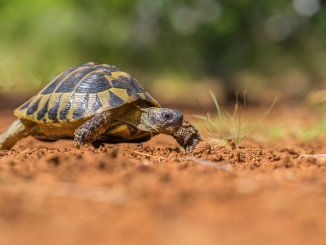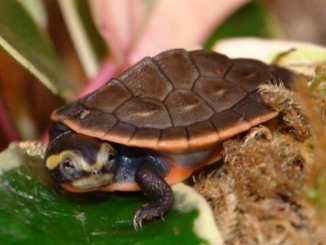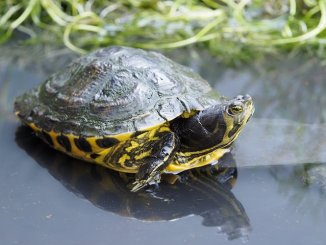The radiated tortoise is a middle-sized tortoise recognized by its domed carapace with intricate yellow lines directed from the center of each dark-green or brown plate, creating a radiating effect.
The tortoise has a black spot on its yellowish-colored head.
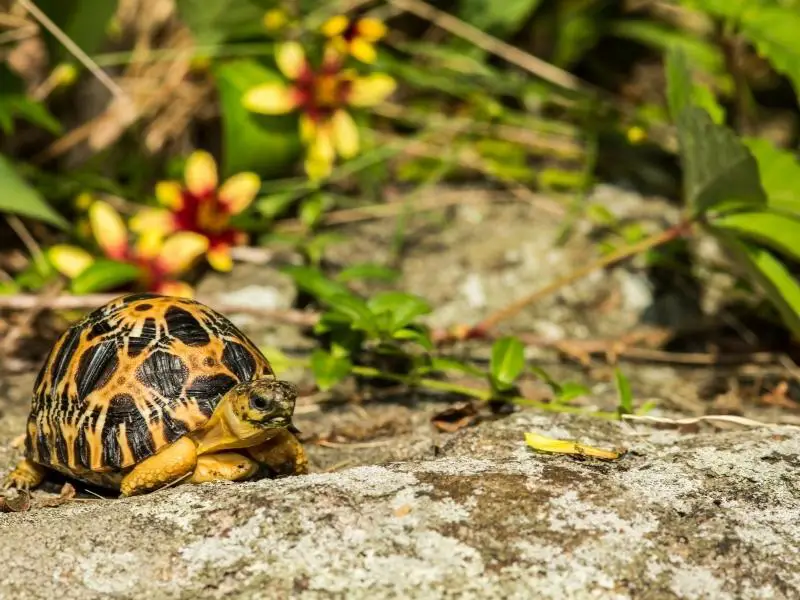
The radiated tortoise species is native to southern Madagascar but is also found in other parts of the island, and has been introduced to the island of Mauritius.
Due to poaching, the radiated tortoise is a critically-endangered species.
Radiated tortoises are relatively easy to care for, as they are hardy and undemanding pets.
However, owners should still monitor their radiated tortoises carefully in order to spot and prevent any health issues.
Radiated Tortoise Overview
| Common Name: | Radiated Tortoise |
| Scientific Name: | Astrochelys radiata |
| Natural Habitat: | Dry forest or woodland of Madagascar |
| Adult Size: | Up to 16 inches in length; up to 35 pounds in weight |
| Average Lifespan: | 60 years |
| Diet: | Herbivore |
| Housing: | Outdoor housing 10 by 15 feet; shelter with a roof; required daytime temperature between 70°F and 95°F |
| Experience Level: | Intermediate/Advanced |
Origin
The radiated tortoise (Astrochelys radiata) is native to the southern part of the island country Madagascar near the African continent.
This tortoise species is also found sporadically in different parts of Madagascarand has been introduced to the islands of Mauritius and Reunion in the Indian Ocean.
Its natural habitat includes dry tropical forests and woodlands with little rainfall and high temperatures throughout the day.
In the wild, radiated tortoises are prey to large snakes and birds. They have protective mechanisms, like screeching loudly to scare the predators away, or hiding in their shells.
According to the IUCN, the radiated tortoise is a critically-endangered species due to almost complete destruction of their habitat, along with poaching activities and exotic pet trade exploitation.
Conservation attempts include California’s captive breeding of radiated tortoises.
Appearance and Behavior
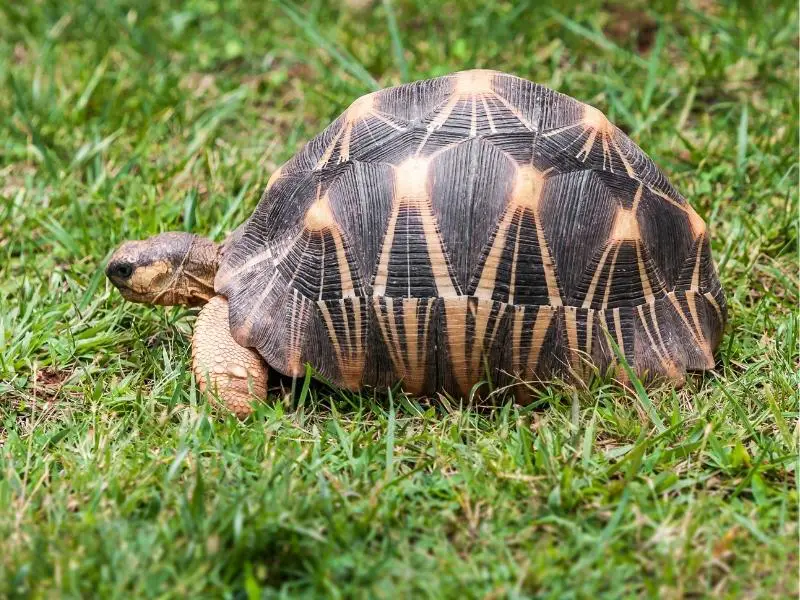
Radiated tortoises have a conventional tortoise body shape, including a round head flattened at the top and elephantine legs.
These tortoises also have a black spot on their yellowish heads, along with a yellow tail and yellow legs.
The radiated tortoise has an oval domed carapace with beautiful star-like patterns.
Bright yellow lines run from the center of each plate of the carapace, creating a recognizable radiating pattern that gives the tortoise its common name.
Male radiated tortoises have longer tails than females, with a noticeable notch beneath the tail. Males are, on average, larger than females.
Males also tend to be more outgoing, while females are usually shy.
Size and Lifespan
Radiated tortoises are medium-sized tortoises reaching up to 16 inches in length in adulthood and weighing up to 35 pounds.
The radiated tortoise is a long-living species: in the wild, its lifespan can be as long as 180 years. However, in captivity, a radiated tortoise lives between 30 and 80 years.
Potential owners should consider the lifespan of the radiated tortoise before getting one, as this tortoise requires a long-term care commitment.
Temperament
Radiated tortoises are friendly and peaceful creatures but can become aggressive when they anticipate a threat.
These tortoises can be housed alone, in pairs, or even with other species, including iguanas, chameleons, and various lizards.
Radiated tortoises are not territorial during the winter, so males can be housed together outside of the breeding season.
However, during the breeding season in the spring, males should be separated to avoid aggression while competing over females.
The radiated tortoise should not be handled too much, which can cause excessive stress and lead to health problems.
The carapace of the radiated tortoise has blood vessels attached to it, so the animal can feel when its shell is touched.
Housing Radiated Tortoises
Radiated tortoises’ natural habitat is dry forests and woodlands with occasional rains.
These tortoises are native to tropical climates with monsoon seasons, so they can adapt to significant weather changes.
However, they are susceptible to lower temperatures and require additional heating if the temperature drops below 50°F.
Radiated tortoises should be housed in spacious enclosures with as much access to natural light as possible. They can be housed in a wooden enclosure or a large vivarium.
Enclosure size
Radiated tortoises will thrive in a spacious outdoor enclosure in warmer climates. Hatchlings will require a 2 by 3 feet enclosure, while adults need at least a 10 by 15 feet housing, which can be used for keeping two to three animals.
Alternatively, they can be housed in a large vivarium of at least 4 by 6 feet (for one tortoise) with consistent access to natural light.
Wood is best used to construct the enclosure, since using materials like steel or concrete can damage the animal’s beautiful shell.
The walls of the enclosure for adult tortoises should be at least 10 inches tall, or 4 inches tall for young tortoises.
If the radiated tortoise is kept outdoors, the enclosure needs to have a hiding spot with a cover where the tortoise can find shade if the temperatures rise excessively.
Lighting
The radiated tortoise enjoys plenty of natural light. The tortoise will receive the necessary amount of light if kept outdoors or given the opportunity to be outside when the weather conditions are suitable.
If the radiated tortoise is housed indoors, place the vivarium close to the source of natural light and provide additional UV lamps to imitate sun exposure.
The best type of UV light to use when caring for a radiated tortoise is Zoo Med T5 UVB.
Temperature and Humidity
The radiated tortoise is used to high temperatures and low humidity in its natural habitat.
If the tortoise is kept in an outdoor enclosure, the perfect temperature during the day is 95°F and no lower than 70°F at night.
If the temperature drops below 55°F, owners should provide the radiated tortoise with an additional source of heat. A 100-160W heat lamp is a good option for the radiated tortoise.
However, to avoid overheating, the enclosure should have enough space to let the tortoise get away from the heating device if necessary.
In order to maintain the necessary humidity levels, do not place the heating lamp above the moist parts of the enclosure.
To provide the radiated tortoise with different microclimates inside the enclosure, put a box with moist sphagnum moss at the end of the enclosure that is opposite from the heat lamp.
The level of humidity in the enclosure should be no lower than 50%. For additional moisture, consider placing a water dish into the enclosure, which the radiated tortoise can drink from or walk in when it needs to cool down.
If the tortoise is kept outside, consider installing a sprinkler to ensure consistent levels of humidity on hotter days.
Substrate and Decoration
The substrate for the radiated tortoise can be sand, peat moss, or topsoil, or combination of these materials. These types of substrate hold moisture well and provide a sift coverage for the radiated tortoise’s enclosure.
Insulate the walls of the enclosure to ensure a dry and warm environment for the radiated tortoise, mimicking its natural habitat. Use hay or moist mulch to insulate.
The enclosure should be decorated with live plants to provide shade, hiding spots, and food for the tortoise. The shade provided by plants allows the tortoise to effectively regulate its body temperature.
Cleaning
To maintain the hygiene of the radiated tortoise, clear out bits of uneaten food from the enclosure and replace the water every day. If there is a water dish or a small pool in the enclosure, the tortoise will use these water sources to drink and dip itself.
At times, the tortoise can also excrete in the water dish, so keep the water dish clean at all times.
Every two weeks, clean the surfaces of the enclosure. Don’t use chemical detergents or soaps, which can harm the delicate animal. Instead, find an animal disinfectant designed specifically for the purpose of cleaning animal enclosures.
Before cleaning the enclosure, place the tortoise in a large, clear container outside of the enclosure.
Radiated Tortoise Care
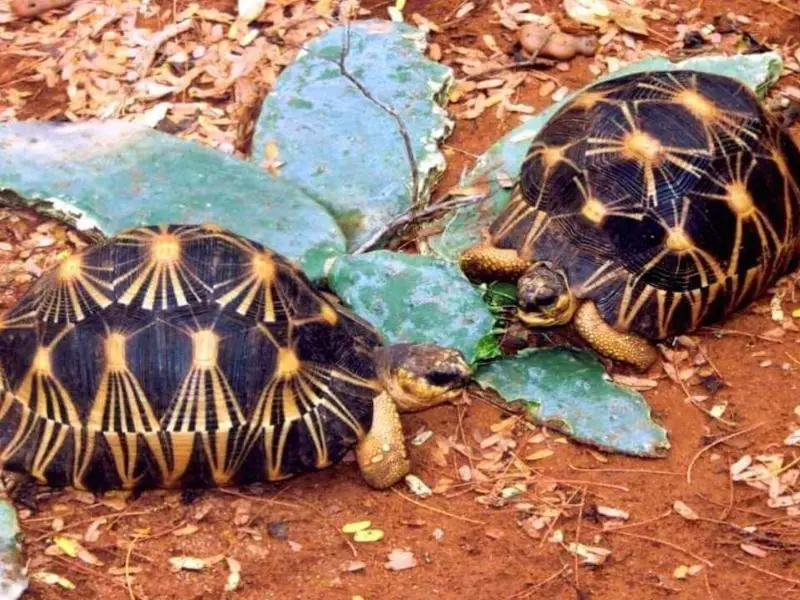
Taking care of a radiated tortoise is moderately difficult. This pet requires careful attention to its everyday needs and an owner experienced enough to recognize problems.
Given its long lifespan, the radiated tortoise also requires a long-term commitment from the owner.
Radiated tortoises are herbivores and need a diverse, plant-based diet to stay healthy.
Despite some common health issues, these tortoises are hardy and adaptable to a variety of conditions and foods.
Food and Water
Radiated tortoises are grazing herbivores. They thrive on a varied, plant-based diet that includes plants, succulents, grass, and flowers.
These tortoises enjoy leafy greens, like kale and bok choy. They can also feed on pre-made foods, like Mazuri and Marion, which should be softened with water before feeding.
Radiated tortoises can also eat fruit, but too much can cause health issues like diarrhea and dehydration.
Introduce some edible plants into the enclosure to provide the tortoises with consistent access to food.
Give the radiated tortoises additional calcium supplements to keep their shells healthy and hard.
Radiated tortoises don’t drink very often, but a water source, such as a water bowl or a water dish, should be kept in the enclosure.
The owner should keep the water clean and replace it regularly.
Handling
The radiated tortoise should be handled rarely and with care — only when there’s an absolute necessity, like cleaning.
The tortoise feels when its shell is being touched, which can cause the animal to feel stress, as though it’s in danger.
If a tortoise is kept in a house with children, make the enclosure inaccessible to younger children to make sure the tortoise is not touched.
Common Health Issues
The radiated tortoise, like many other tortoise species, is susceptible to pyramiding — a condition caused by irregular shell development. It leads to an excessive vertical growth of the shell’s scutes.
Pyramiding is a result of incorrect enclosure conditions, like low humidity.
While the pyramid-like scutes cannot be treated, pyramiding can be prevented by ensuring stable humidity levels in the enclosure and providing the tortoise with a consistent, high-fiber, low-protein diet.
Radiated tortoises can also develop respiratory problems if the temperature gets too low.
Common symptoms of respiratory diseases include loss of appetite, apathy, difficulties in breathing, inflammation around the eyes, and discharge from the nose.
Minor respiratory symptoms can be treated with regulation of the temperature in the enclosure. However, if the condition does not get better with a temperature adjustment, show the tortoise to a vet.
The radiated tortoise can suffer from abscesses — bumps or swelling on any part of its body. These abscesses usually appear near the eyes and ears of the tortoise.
The most common cause of abscesses is a lack of vitamin A, which can be remedied with supplements.
The radiated tortoise can be prone to parasites. The first signs of parasites are diarrhea and weight loss.
If you notice these symptoms, show the tortoise to a vet immediately, as these symptoms indicate the animal has had parasites for a long time.
Breeding
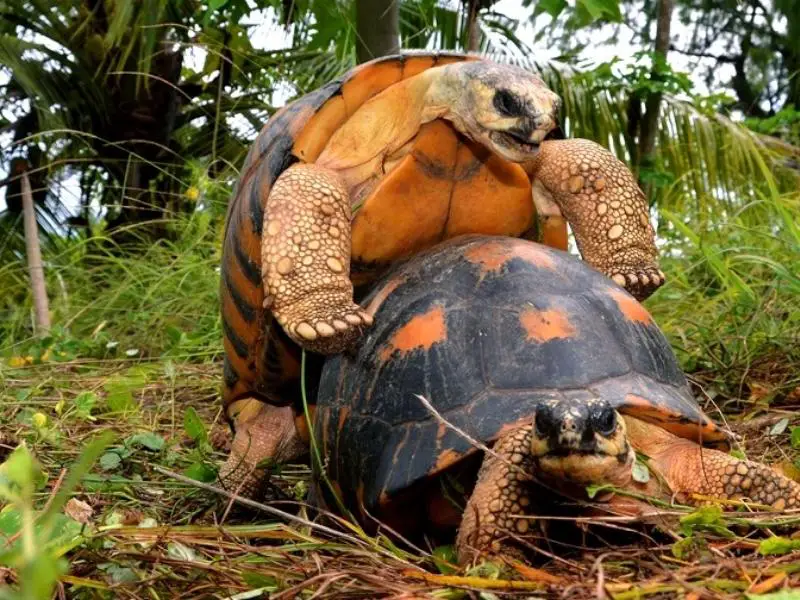
Radiated tortoises reach sexual maturity when their shell is developed to the length of 11 to 12 inches.
They can reproduce all year, depending on the conditions in the enclosure.
In their natural habitat, radiated tortoises breed at the start of the rainy season, which means breeding activities can be triggered by raising the humidity in the enclosure.
To increase competition and raise mating interests in the tortoises, introduce more than one male into the enclosure. Males will compete for female attention by fighting.
The male will signal attention to the female by circling around her.
Females usually produce up to six eggs, which they lay in a nest they dig out in the substrate. The process of reproduction takes up to 120 days.
The eggs need to be incubated at a temperature gradually rising to 86°F within the first 30 days.
Humidity should be increased to 75% while the eggs hatch, approximately 120 days since the eggs were laid.
Choosing and Buying a Radiated Tortoise
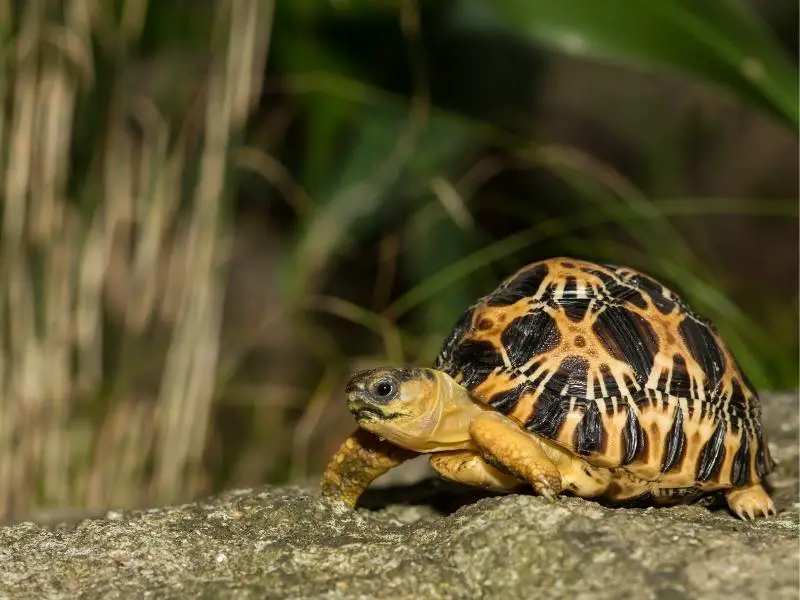
Radiated tortoises are an endangered species, so they should always be purchased from reputable breeders who breed them in captivity.
In recent years, radiated tortoises have become more available in the United States as a result of conservation efforts.
These pets can cost between $800 to $2,500 depending on their age and the reputation of the breeder.
When selecting a radiated tortoise, watch carefully for any worrying signs that might point to illness, including apathy, breathing difficulties, or signs of an underdeveloped shell.

